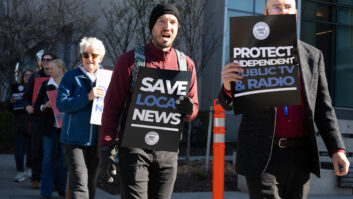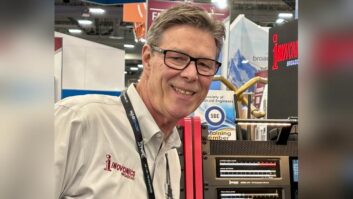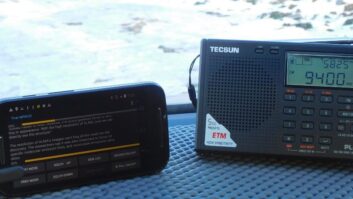
This is one in a series of Radio World stories reporting reactions from industry tech and regulatory experts on the FCC’s October actions in support of AM radio stations in the United States.
Over the last few weeks, a flurry of insider wrangling has taken place at and around the FCC, as advocates and detractors debated the best ways to support AM stations seeking FM translators.
For one participant in the revitalization discussion, efforts came to fruition in the form of a 250-mile waiver as part of the final order. The waiver will allow AM stations to move an FM translator up to 250 miles. This will provide immediate relief, said John Garziglia, partner with the Washington firm Womble Carlyle. It’s part of the commission’s two-pronged translator approach; a second prong will be the opening of new FM translator application auction windows.
The benefits of a 250-mile waiver are clear, Garziglia said. It allows for an AM broadcaster to obtain an FM translator at a known cost, to receive an FCC grant within approximately 50 days of making the deal, to know within days of filing the application whether there are any conflicting applications and to make confident business plans for putting the FM translator on the air.
By contrast, he said, “An auction filing window is a crapshoot in which the window-filed application, once the window is open for filing, is not public until being revealed a month or more after its filing. Only then, the broadcaster discovers whether or not the application is mutually exclusive with any other applications.”
Consider the headaches that may arise if a broadcaster is not able to reach a settlement with other mutually-exclusive applicants, he said. “If there is no settlement, the applications go to auction to the highest bidder. Not until the conclusion of the auction does the broadcaster know whether he or she will obtain the FM translator, and at what price. That is not a good way for an AM broadcaster to make business plans.”
It was such forceful claims that apparently helped the waiver argument find favor within the commission halls.
Adoption of the 250-mile waiver was spurred by the 2012 waiver request known as the Tell City waiver, he said. Filed by Garziglia’s firm Womble Carlyle on behalf of the Cromwell Radio Group, that application asked the FCC for permission to move a translator in Central City, Ky., a greater distance than allowed under current rules. The AM that would be paired with the FM translator in question was in Tell City, Ind.
The Tell City application asked the FCC to change a requirement that a modified translator facility must be mutually exclusive with the licensed facility for a move to serve an AM station. Instead, the application sought a requirement that both the licensed and proposed translator facilities be within the proposed AM primary station’s 0.025 mV/m interfering contour to be eligible to move.
The commission had denied this application, saying such a change might not protect other applicants. Subsequently, the Multicultural Media, Telecom and Internet Council and the translator seller Way Media Inc. filed an appeal, which remains pending at the FCC.
But in the new AM order, the commission agreed with the underlying issues, saying the addition of a 250-mile waiver will give greater flexibility to stations. “While the AM revitalization order did not take any specific action on the Tell City waiver, the overall relief requested by the Tell City was granted by the FCC in the form of the 250-mile waiver,” Garziglia said.
The benefits of the 250-mile waiver are significant, he said; it will reshuffle the multitude of FM translators now out on the market and put them to their best possible use. “An AM-only FM translator auction filing window will only add additional translators to the current FM translator glut, rather than realigning existing translators to locations where they can be best used,” he said.
“Every day while the 250-mile waiver opportunity is open will be a new filing day for purposes of conflicting applications,” Garziglia said, adding that AM broadcasters who take best advantage of the 250-mile waiver will be those who are quick and nimble.
Critics who called the 250-mile waiver unworkable were “misguided,” he said. “One industry representative was repeatedly quoted that the 250-mile waiver was worse than doing nothing at all,” he said. Instead, he expects a large number of AMs will successfully use the 250-mile waiver to obtain an FM translator, buoyed by the certainty afforded by the process.
Garziglia reiterates that he is not opposed to an AM-only FM translator auction filing window, only that that this type of auction window filing will take time to implement. As it stands today, the AM-only FM translator auction window will open in 2017. The FCC will begin accepting 250-mile waiver applications in the first quarter of 2016.
Overall, he said, the two-pronged solution will undoubtedly alter the health and balance of the AM and FM bands for the better. “For a number of years, we have been at a precipice for AM broadcasting. Those AM stations that are and will be paired with FM translators will have a high expectation for survival; first with an FM translator, and then with all-digital AM once there is a sufficient proliferation of HD Radio receivers in the marketplace.
<“Pairing FM translators with AM stations was the only action that was open to the FCC that would have an immediate, substantive, effect upon the survival prospects of the service to listeners provided by many AM stations.”
In the end, the focus is where it should be: on the listenership. “Too often in our regulatory endeavors, we get distracted from focusing on what should be our primary goal, which is our service to the public,” Garziglia said. “FM translators result in better radio reception for the listeners of the many AM stations that have provided local and community information and programming for many decades.”







